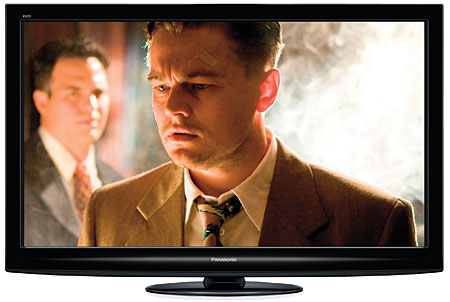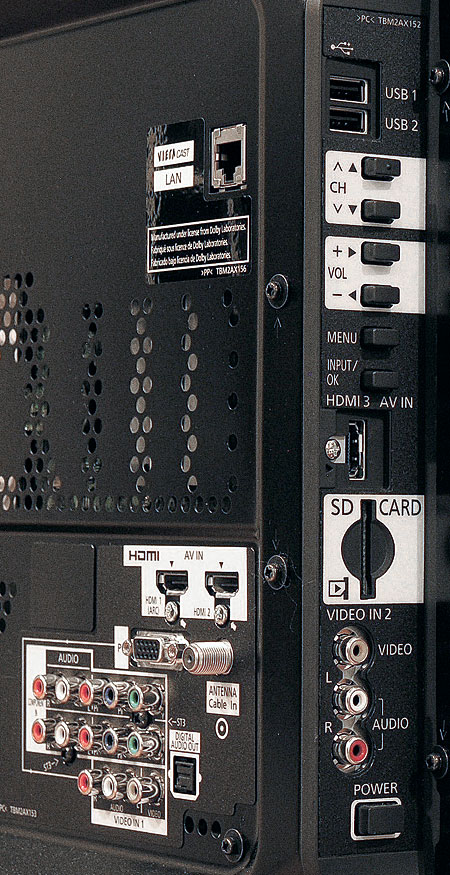Panasonic Viera TC-P50G20 Plasma HDTV
 Price: $1,500 At A Glance: Superb resolution • Accurate color in THX mode • Black level disappoints, but still solid • 2D only
Price: $1,500 At A Glance: Superb resolution • Accurate color in THX mode • Black level disappoints, but still solid • 2D only
Price and Performance

LCDs are now soaking up a larger and larger percentage of the market, and it’s been hard slogging for plasma displays. But that doesn’t faze Panasonic. As the sole remaining major Japanese plasma manufacturer, it offers a huge range of models. Yes, Panasonic also does LCDs, but only in smaller sizes. If you see a Panasonic HDTV that’s 46 inches or larger, it will be a plasma.
While those of us who cover the field recognize the dramatic advances in LCD technology in the last few years, many of us appreciate the things that plasmas still do better than LCDs. Exhibit A is the subject of this review—the new Panasonic Viera TC-P50G20.
Inside and Out
Panasonic’s G20 series is strictly 2D and offers 50- and 54-inch models. As of this writing, they are exclusive to Best Buy stores. If you shop for either set elsewhere, you’ll have to opt for another Panasonic line. The G25 models appear to be nearly the same as the G20s and include identical prices for sets of the same size. The only differences are the addition of a Viera Link connection for a home network camera on the G25s, as well as additional 42- and 46-inch G25 models. Both lines are THX certified and ENERGY STAR qualified.
The TC-P50G20 has a relatively plain, gloss-black bezel. At 3.5 inches deep (without stand), it isn’t a member of the thinner-isin club. Along with Panasonic’s higher-end models, this set is equipped with the company’s newest Infinite Black Panel (Infinite Black Pro in the 3D designs). According to Panasonic, this updated screen filter is better at rejecting reflections and offers deeper blacks.

There are five preset Picture modes: Vivid, Standard, THX, Game, and Custom. Each of them (including THX) is individually user adjustable and assignable to different inputs. But the settings are global for each mode; you can’t tweak them separately for each input. I recommend that you use the THX mode for your most critical viewing, as I did.
The Panasonic offers a range of video controls, many of which are best left in their default, or off, positions. The most accurate Color temperature setting was Warm2. There are white-balance controls (W/B, high and low, for red and blue) and six Gamma options. The 3:2 pulldown control is an Auto/On/Off film mode. The Black level control worked best in the Light position, and a set of Aspect adjustments produced minimum overscan with an HD source when the Screen format control was set to Full and the HD size control to Size 2.
A Color management adjustment suggests the presence of a full color management system, but here it’s simply an On/Off control that I left off. A three-level Panel brightness control had little effect, either visible or measured.
For 1080p/24 sources, a 24p Direct in setting gives you the choice of either 48 hertz (frames per second) playback (each 24-fps frame flashes twice, with no 3:2 pulldown) or 60 Hz (the set converts the 24-fps source to 60 fps with 3:2 pulldown). With earlier Panasonic sets, the 24-fps setting decreased brightness and added visible flicker on scenes with large expanses of white or a uniform color (a bright blue or clouded sky, for example). The flicker was relatively subtle here, but I noticed the reduced brightness. Because of this, I did much of my viewing in the 60-Hz mode. The increased judder that the 3:2 pulldown caused didn’t bother me.
- Log in or register to post comments




















































